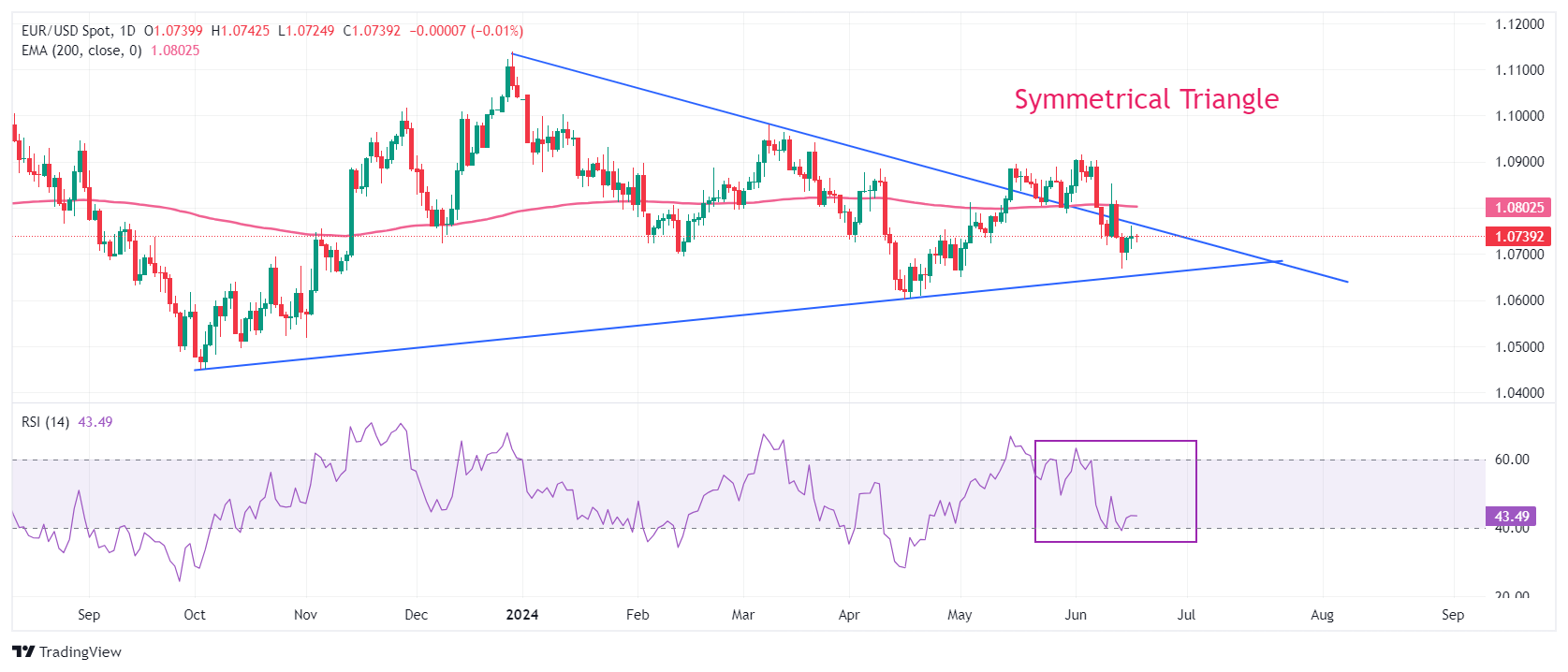EUR/USD achieves firm footing above 1.0700 as Fed rate-cut bets soar

- EUR/USD trades sideways above 1.0700 as investors look for fresh cues on the Fed and the ECB interest-rate outlook.
- ECB policymakers remain concerned over stubborn service inflation.
- Investors see the Fed reducing interest rates twice this year.
EUR/USD consolidates in a tight range above the round-level support of 1.0700 in Wednesday’s New York session. The major currency pair trades sideways as investors look for fresh cues about when the European Central Bank (ECB) will deliver its second rate cut this year.
The ECB began reducing its key interest rates earlier in June as policymakers believe that inflation in the Eurozone is on course to return to the desired rate of 2%. However, ECB officials have been refraining from committing to any specific interest rate-cut path as they remain concerned over high inflation in the services sector.
ECB policymakers worry that the adaptation of an aggressive policy easing approach could revamp price pressures again. Officials have projected a bumpier inflation path and see price pressures declining to the 2% target in 2025.
Meanwhile, French political uncertainty continues to keep the Euro on the tenterhooks. Investors worry that the formation of Marine Le Pen ‘s-led-National Rally’s (RN) government after the Parliament elections would trigger financial distress in the European Union’s (EU) second-largest economy. The RN has promised a lower retirement age, energy price cuts, more public spending and “France first” economic policies in its manifesto.
Daily digest market movers: EUR/USD turns quiet amid uncertainty over French elections
- EUR/USD trades in a tight range, slightly above 1.0700, as the US Dollar (USD) consolidates inside Tuesday’s trading range. The near-term outlook of the US Dollar has become uncertain as slower-than-expected United States (US) Retail Sales growth in May has boosted market expectations for Federal Reserve (Fed) rate cuts in the September meeting.
- The monthly Retail Sales report showed on Tuesday that lower gasoline prices, subdued demand for building materials, and a decline in sales at food services and drinking places were major drags. Still, retail sales grew slightly in May after contracting by 0.2% in April, downwardly revised from a stagnant performance. However, the growth rate was only 0.1%, lower than the estimates of 0.2%.
- According to the CME FedWatch tool, 30-day Fed Fund Futures pricing data shows a 67% chance for a rate cut in September, up from 61.5% recorded before the release of the May Retail Sales report. The tool also shows that policymakers will announce one more rate cut in the November or December meeting, which is contrary to the Fed’s dot plot, in which officials signaled only one rate cut this year.
- Fed policymakers keep favoring the maintenance of current interest rates until the last quarter of this year as encouragement from a higher-than-expected decline in price pressures in May is insufficient to build confidence for rate cuts. Officials have been emphasizing the need for more good inflation data before pivoting to policy normalization.
Technical Analysis: EUR/USD rises to 1.0750
EUR/USD trades close to the immediate resistance of 1.0750. The downward-sloping border of the Symmetrical Triangle formation on a daily time frame, plotted from 28 December 2023 at 1.1140, is acting as a major barrier for the Euro bulls.
The major currency pair is expected to find support at 1.0636, near the upward-sloping order of the chart pattern plotted from 3 October 2023 low at 1.0448 and the horizontal cushion plotted from April 16 low around 1.0600.
The long-term outlook of the shared currency pair has also turned negative as prices dropped below the 200-day Exponential Moving Average (EMA), which trades around 1.0800.
The 14-period Relative Strength Index (RSI) falls below 40.00. Momentum could turn bearish if the RSI sustains below this level.
Fed FAQs
Monetary policy in the US is shaped by the Federal Reserve (Fed). The Fed has two mandates: to achieve price stability and foster full employment. Its primary tool to achieve these goals is by adjusting interest rates. When prices are rising too quickly and inflation is above the Fed’s 2% target, it raises interest rates, increasing borrowing costs throughout the economy. This results in a stronger US Dollar (USD) as it makes the US a more attractive place for international investors to park their money. When inflation falls below 2% or the Unemployment Rate is too high, the Fed may lower interest rates to encourage borrowing, which weighs on the Greenback.
The Federal Reserve (Fed) holds eight policy meetings a year, where the Federal Open Market Committee (FOMC) assesses economic conditions and makes monetary policy decisions. The FOMC is attended by twelve Fed officials – the seven members of the Board of Governors, the president of the Federal Reserve Bank of New York, and four of the remaining eleven regional Reserve Bank presidents, who serve one-year terms on a rotating basis.
In extreme situations, the Federal Reserve may resort to a policy named Quantitative Easing (QE). QE is the process by which the Fed substantially increases the flow of credit in a stuck financial system. It is a non-standard policy measure used during crises or when inflation is extremely low. It was the Fed’s weapon of choice during the Great Financial Crisis in 2008. It involves the Fed printing more Dollars and using them to buy high grade bonds from financial institutions. QE usually weakens the US Dollar.
Quantitative tightening (QT) is the reverse process of QE, whereby the Federal Reserve stops buying bonds from financial institutions and does not reinvest the principal from the bonds it holds maturing, to purchase new bonds. It is usually positive for the value of the US Dollar.
